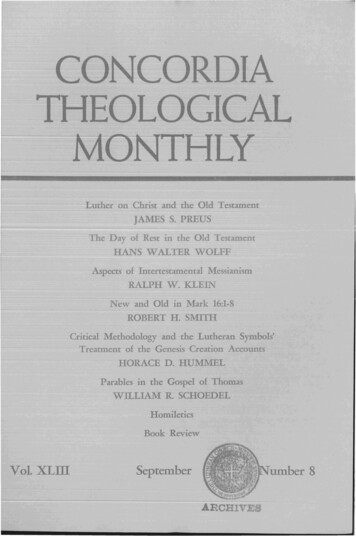
Transcription
CONCORDIATHEOLOGICALMONTHLYLuther on Christ and the Old TestamentJAMES S. PREUSThe Day of Rest in the Old TestamentHANS WALTER WOLFFAspects of Intertestamental MessianismRALPH W. KLEINNew and Old in Mark 16:1-8ROBERT H. SMITHCritical Methodology and the Lutheran Symbols'Treatment of the Genesis Creation AccountsHORACE D. HUMMELParables in the Gospel of ThomasWILLIAM R. SCHOEDELHomileticsBook ReviewVol. XLillSeptemberumber 8ARCHIV
ParablesInthe Gospel of Thomas:Oral Tradition or Gnostic Exegesis?WILLIAM[The author is an acknowledged authority in the field of Gnostic studies andhas contributed significant articles to leading journals and edited several texts in thisarea. Thus his article becomes a real testof pastoral relevance. What do the scholarand the pastor have in common? Paul'sanswer is applicable: "Much in every way."In the first place, a high percentage ofLutheran pastors, and others also, are competent scholars who delight in such articles for stimulation and up-dating. Inthe second place, D r. Schoedel providesimportant light on a burning contemporaryquestion concerning the authority of theScripture. He does this by studying theattitude of an important early group ofChristians to the sayings of Jesus. He concludes that the Gnostic Christians who produced the Gospel of Thomas did not hesitate to edit and change the sayings of Jesusto suit their own theological viewpoints.Of course, our first inclination is to say,"See how the heretics treated the words ofJesus! Orthodox Christians would neverdo that." But this is too simple an answer.As Walter Bauer has argued, the Gnosticsfor a long time were not considered heretical. Furthermore, the orthodox communities manifested something of this samefreedom as is evident in the hundreds oftextual variants that exist. These variantswere not always caused by the sleepy scribeworking in the dim light of the oil lamp.Many of them were done deliberately fortheological reasons, so that men of the earlychurch are marked by a freedom towardinterpreting and applying the words ofJesus by changing them to meet new prob-R.SCHOEDELlems. The criterion seems always to havebeen faithfulness to the person of JesusChrist according to the best lights of thescribe.The author is professor of religiousstudies at the University of Illinois.}The sayings of Jesus contained in theGospel of Thomas l are of such a character that at least some of them may establish themselves as variants of an authentictradition not directly dependent on thesynoptic gospels. The methods of formcriticism have been put to use in this connection, and the results have convincedmany that in Thomas we catch sight of anoral tradition that may well enrich ourunderstanding of the teaching of the historical Jesus. There is wide agreement thatno judgment on the gospel as a whole canbe passed but that each saying must beinvestigated separately to establish its placein the tradition.There are few who believe, however,that Gnostic influences are entirely absentfrom Thomas. Its place among the predominantly Gnostic treatises discovered atNag Hamadi makes such a suggestion natural. More important are the Gnosticizingtendencies reflected in many of the sayings. It is possible that even the more innocent statements of the gospel were understood as conveying Gnostic truth in aveiled form. Yet to suggest a Gnostic (or1 A. Guillaumont et aI., The Gospel According to Thomas (Leiden: E. J. Brill, 1959).548
PARABLES IN THE GOSPEL OF THOMASGnosticizing) milieu for Thomas is not torule out the possibility that words of Jesusfrom a tradition independent of the synoptic gospels were used at some stage (orstages) in its composition. Traces of different forms of Thomas circulating in thesecond century increase this possibility.The purpose of this study is to raise aquestion: To what extent can the primitivefeatures of sayings in Thomas noted byform critics also be explained as variantsreflecting the interests of Gnostic exegesis?If we find that differences between Thomasand the synoptics can be interpreted asarising from Gnostic concerns, muchgreater caution will be required in employing the methods of form criticism in thisconnection. Here we propose to investigate only a few examples in order to suggest what further research along these linesmay bring to light. A number of parablesfrom Thomas are taken as the point of departure for this investigation since parableswere regarded as especially mysterious inGnostic circles and we know what severalof them were taken to mean in such asetting. We look first at the role that sayings of Jesus played in the debate betweenGnostics and the orthodox and then takeup a number of examples which suggestthat at least some of the parables inThomas may be comprehensible againstsuch a background. 2L SAYINGS OF JESUSIN SECOND CENTURY CHRISTIANITYPolycarp of Smyrna knew of Gnosticallyinclined heretics who "twist the sayings of2 For earlier suggestions along the linesadopted in this study see especially G. Garitteand 1. Cerfaux, "Les parables du royaume dansl'Evangile de Thomas," Le Museon, 70 (1957),307-327.549the Lord" (Phil. 6: 1). This suggests thatearly in the second century the sayings ofJesus constituted a special source of authority and that they received special scrutiny. But it is generally overlooked thateven later in the second century there isstill significant evidence of the same special place occupied by the words of Jesus.That evidence is provided by Irenaeus,bishop of Lyons, in his books AdversusHaereses.It appears that Irenaeus at first intendedto recount Gnostic myths in one book andto refute them in a second from the standpoint of rational argument. But he wassoon convinced that special attention hadto be given to the exegesis of Biblical writings. In the third book of his ramblingwork against the heresies, he devotes special attention to the witness of apostles.Then in book four he claims to turn to the"words of the Lord" and to pay specialattention to the parables (Adv. R aer.3,25,7; 4 Praef. 1; 4,41,4). In book five heproceeds to "the rest of the sayings of theLord - that is, those which he spoke notby way of parables but in simple speechconcerning the Father" (Adv. Raer. 4,41,4;d. 5 Praef.) as well as to especially difficult passages in Paul. It does not greatlymatter that Irenaeus' reflections rove farbeyond his stated intention: in book four,for example, the treatment of parablesbegins only in chapter thirty-six. 3 The important thing is the special place that"words of the Lord" and parables still holdeven after something approaching a canonof New Testament writings had been3 For Adversus Haereses, book four, see particularly Ade1in Rousseau et aL, Irenee de Lyon:Contre les heresies, livre IV (Paris: Les editionsdu Cerf, 1965).
550PARABLES IN THE GOSPEL OF THOMASachieved and the four gospels functionedas theological authorities in their totality.There can be little doubt that this continued segregation of the "words of theLord" owes something to the particularinterest devoted to them by Gnostics. It issignificant that in his second book, beforehe had turned to Biblical exegesis in detail, Irenaeus makes special mention of theValentinian interpretation of the parables.He indicates that his opponents emphasizethe obscurity of the parables and the needto explain them in terms of Gnostic mysteries. (Adv. Haer. 2,27,1)Confirmation of the particular interestof Gnostics in parables comes to us nowfrom the Epistula lacobi Apocrypha,4 Jesusappears to his disciples after the resurrection and says: "I spoke with you before inparables, and you did not understand; nowI speak with you openly, and you do notperceive" (7:1-6). Jesus complains thatthe disciples have held him back "anothereighteen days because of the parables" (7:37-8: 4). This, we are told, "sufficed forsome men: They heard the teaching, andthey understood 'the shepherds' and 'thesowing' and 'the house built' and 'the lampsof the virgins' and 'the wage of the laborers' and 'the double drachmas and thewoman'" ( 8 :4-10 ). Clearly the parablesof the New Testament were regarded asparticularly arcane and in need of specialelucidation.It is unfortunate, then, that we do nothave extended examples of Gnostic exegesis of the words of the Lord and theparables. Nor have the fragments that wedo possess been brought together and prop4 Michel Malinine et al., Epistula IacobiApocrypha (Zurich und Stuttgart: Rascher Verlag, 1968).erly studied. CaroIa Barth's volume on theinterpretation of the New Testament inValentinian circles is of some help to us.5But it must be used with caution not onlybecause of its incompleteness but also because of a failure to distinguish clearly between materials in Clement of Alexandria'sExcerpta ex T heodoto which are genuinelyGnostic and those which represent comments of Clement.6 A word about her conclusions, however, is in order.In her discussion of the Biblical textused by the Valentinians, Barth shows thatit often varies from the manuscripts usedin modern editions of the New Testament.Yet neither Irenaeus nor Tertullian chargethem with altering the text. The changesmust have seemed insignificant when compared with the radical "higher criticism"of Marcion. A closer inspection shows,however, that the Valentinians did havereadings that supported their own teachings in ways that the normal text did not.For example, Valentinians (in Exc. ex.Theod.49, 1) read Rom. 8:20 as referringto the demiurge: "He was subjected to thevanity of the world, not willingly, but because of him who did the subjecting, inthe hope that he too might be freed. . . ."Barth does not classify the changes thatoccur in Valentinian texts of the New Testament, but a perusal of the passages whichshe prints shows that texts were frequentlyshortened and simplified, that additionswere sometimes made, that verses wereoften enriched by words drawn from other5 Die Interpretation des Neuen Testamentsin de., Valentinischen Gnosis, "Texte und Untersuchungen," 37/3 (Leipzig: ]. C. Hinrichs,1911) .6 Cf. F. Sagnard, Clement d'Alexandrie:Extraits de Theodote (Paris: Les editions duCerf, 1948).
PARABLES IN THE GOSPEL OF THOMASpassages in related contexts, that c .1angesof order (occasionally significant 7) occur,that what we may call simple variants areto be found. Considerable freedom, then,is still to be found in the quoting of NewTestament materials, and not all of it wasinnocent. It will be well to bear this inmind when looking at the variants of theGospel of Thomas.We must be aware, however, that textual variants may mean dit1erent things indifferent settings. It is clear that the Valentinians were dealing with documents practically identical with our gospels. In theapostolic fathers, however, this is not necessarily so, and Helmut Koster has arguedthat the sayings of ]es;]s which appearthere still reflect oral tradition. s There isthe even more complex possibility that awriter using a 'written source may alter itunder the influence of oral tradition. This,in fact, is the way in which some variationsin the synoptic gospels are regularly explained in contemporary New Testamentscholarship. The student of Thomas mustremain open to all such possibilities.Exegesis represented a more fundamental divergence between Gnostics and thechurch bthers than did texroal variants.Carola Barth analyzes the traces we haveof Valentinian interpretation of the parables and comes to these conclusions: Valentinians treated the parables as allegoriesand saw in them the outlines of their owncosmological, soteriological, or eschatolog7 In Irenaeus, Adv. Hae1". 1,8,3, the threeraces of men are found in Luke 9:57-62 bysetting the text in a different order: Jesus addresses the hylics in Luke 9: 58; the psychics inLuke 9:62; the pneumatics in Luke 9:60.8 Synoptische Uberlieferungen bei den apostolischen VJtern, '"Texte und Untersuchungen,"65 (Berlin: Akademie-Verlag, 1957).551ical teachings; the interpretation concernedthe parable as a whole or single itemswithin it; "for the most part it fastenedon a single striking word"; occasionallynumbers in the parables served as a pointof departure for allegorical speculation.9Some enrichment of our understanding ofthis exegetical activity may be gained bycomparing the orthodox interpretation ofthe parables in Irenaeus (Adv. Haef. 4,3 ') ff.) . . Jce this was directed againstGnosticism, we may expect to catch sightof some points at issue. Our study suggests that against this background, freedomin quoting the New Testament in Gnosticcircles ronld becomE' liC';D : to reformulateit for theological reasons.Cur study also suggests that such reformulation occasions changes that may be mistaken for authentic primitive features. Theclaim is not that the Gnostics anticipatedcontemporary methods of form criticism.The two movements represent fundamentally different orientations. Yet they doshare a common concern to penetrate thegospel traditions and to une8.rth the original meaning. Both isolate the sayings ofJesus from their context in the gospels.Both attempt to get behind the ecclesiastical interpretation and to clear away misinterpretations. Carola Barth flO red thatValentinian interpretations of the parablesregularly neglect the "explanations" ofthem that appear in the New Testament.10re shnot surprised, then, to findthat Gnostic exegesis and the results ofform criticism coincide in important respects.The freedom that Gnostics felt in deal9 Barth, Die Interpretation des Neurin Testaments, pp. 64-65.10 Ibid., pp. 60-62.
PARABLES IN THE GOSPEL OF THOMAS552lng with the New Testament arises fromtheir confidence that Jesus himself had revealed the meaning of his sayings to hisdisciples after the resurrection. They carried further a tendency already decisive inthe gospels of the New Testament to interpret the words and deeds of Jesus in lightof the events that took place at the end ofHis ministry. In such an atmosphere it isnot difficult to imagine why words andparables of Jesus could not only be alteredbut even created. To take an extreme example, we find imbedded in a discourse ofJesus in the Epistula lacobi Apocrypha (7:22-32) a parable in which the "Kingdomof Heaven" is likened to,1" a palm prallenwhose fruit fell about it;it sent forth leavesand, when they sprouted,they made the pith U} dry up.So it is with the fruitwhich came forth from this single Root.When it was planted P},fruits were brought forth from many.Neither the parable nor its explanation 11will commend themselves as authentic tomany! Instead of a sharply focussed narrative from everyday life we have a symbol11 In 8:16·25 the "word" is likened to "agrain of wheat" which produced "many grainsin the place of one." In 12: 22-31 we are toldthat the Kingdom of Heaven is like an ear ofcorn which sows its own fruit and fills the fieldagain. The parable of the palm branch reflectsa similar emphasis (the many from the one)but is complicated by the immediately precedingdirection not to let the Kingdom "wither" (or"perish") which seems to be in some tensionwith the drying up of the pith of the branch.Could the dried pith refer to Jesus who wishesto leave now that he has planted his fruit andexhausted his strength? It is immediately afterthis that he complains about being retained bythe disciples (7:37-8:4).pregnant with mysterious meaning. Hereas elsewhere in Gnostic settings the symbol has to do not with the coming of theKingdom but with the unfolding of theinner man; for Gnostics had learned fromLuke that the kingdom of God is "withinyou" (Luke 17:21; d. Gospel of Thomas3; Hippolytus, Ref. 5, 7, 20).12 We aresuggesting that the tendency to create andto reformulate parables from this point ofview cannot be neglected when Thomas isstudied.II SOME PARABLES IN THEGOSPEL OF THOMAS\Yje turn now to take a closer look at fiveparables selected from the Gospel ofThomas. 1\J1 have parallels in the l'JewTestament. Four contain elements generally recognized as more advanced than thecorresponding forms in the synoptic gospels. The fifth has been hailed as moreprimitive. But the question is the same inall instances: do these parables in theirpresent form go back to a tradition independent of the synoptic gospels? A parable felt to have features more primitivethan its New Testament parallel will illustrate the possibilities of a form critical approach more fully; parables felt to havemore advanced features will tend to conceal these possibilities; but, as we shall see,the study of the latter is valuable for assessing the significaIlce of important featuresof the former.A. The Dragnet (Gospel of Thomas 8)1. Man is like a wise fisherman2.who cast his net in the sea;3. he drew it from the sea12 Cf. W. R. Schoedel, "Naassene Themesin the Coptic Gospel of Thomas," V igiliaeChristia17ae, 14 (1960), 225.
PARABLES IN THE GOSPEL OF THOMAS4.S.6.7.8.9.10.full of little fish.Among them the wise fisherman founda big good fish.He threw all the little fishdown into the sea.He chose the big fish without trouble.He who has ears to hear let him hear.The major differences between this andMatt.13:47-S0 (to which it seems to berelated) are three: (1) it is a parable notabout the Kingdom but about "man" or"The Man" (line 1) -presumably theinner man OJ' ''Lan; (2) theprocess of selection (lines 2-9) comes toconcentrate on one "big good fish" (eitherJesus the Primal IVlan or the inner manvlhom the Primal Ivlan finds); (3) thelack of any parallel to Matthew's conclusion in which we are told that this is likethe judgment when the angels will comeand separate the evil from the good andcast the former into the "furnace of thefire." (Matt.13:49-50)There is little quarrel about the advancednature of the form of this parable. Conceivably we have exaggerated its Gnosticcharacter: we may be dealing simply withan allegory of man finding Christ. One isreminded of the "great fish" - Christmentioned in the Abercius Inscription andelsewhere (d. Tertullian, De Baptisma,1). In any event, the interpretation emphasizes the symbolic significance of elements in the parable and cannot be regarded as primitive. The parable showshow reinterpretation leads to the creationof something quite new.Yet it is always possible that such reinterpretation is based on a primitive tradition not dependent on the New Testament gospels. Is there any evidence in thiscase? The neglect of the Matthean expla-553nation in terms of judgment (Matt. 13:49-50) could be taken as pointing to anoral tradition which as yet did not knowthis "artificial" explanation. The lackthroughout Thomas of explanations likethose given in the New Testament support this impression. V/l e may be in touchwith a tradition independent of the gospels in spite of the advanced character ofthe interpretation.We have already indicated, however,that the Valentinian exegesis of the parables also regularly neglects the explanations of parables provided in the NewTestament. .As we shall see shortly, suchexplanations were apparently regLded notonly as inadequate but often as totally unsatisfactory. The same .may be true of theparable of the dragnet. For the e'Cplanation has to do with judgment, and judgment was not a welcome theme in Gnosticizing theology. The framer of Thomas'parable may well have consciously rejectedthe conclusion to the parable in Matthew.This possibility is increased when we seewhat Irenaeus does with similar elementsin other parables. He understands thetheme of judgment in the parable of thesheep and the goats and in the parable ofthe tares to prove that it is one God whoboth confers salvation and casts into fire not two gods as the Gnostics argued intheir desire to distinguish the God of justice from the God of perfect goodness(Adv. Haer. 4, 40, 2). Against this background Thomas' lack of interest in Matt.13: 49-50 becomes intelligible.Definitive proof that Thomas used theGospel of Matthew in this instance is notpossible. But the peculiar features of theparable seem to be readily understandableagainst the background of developmentsin the second century.
554PARABLES IN THE GOSPEL OF THOMASB. T he Weeds (Gospel of Thomas 57)1. The Kingdom of the Father is like aman2. who had good seed.3. His enemy came at night4. (and) sowed a weed among thegood seed.5. The man did not allow them6. to pull up the weed.7. He said to them:8. Lest by chance you go to pull up theweed9. (and) you pull up the wheat with it.10. For on the day of the harvest11. the weeds will appear12. (and) they will be pulled up andburned.Differences Detw"een this and Matt. 13:24-30, 36-43 include the following:( 1) the neglect of the explanation in Matt.13 : 36-43; (2) general simplification andshortening of the parable (e. g., the wholeof Matt. 13: 26-28 has no parallel inThomas); (3) in particular, the failure tomention the "servants" (Matt.13:26) orthe "harvesters" and the charge given them.(Matt. 13:30)It is generally conceded that the formof the parable is inferior to that found inMatthew. "The man did not allow them"(line 5) refers to the servants mentionedin Matthew; the reference is unintelligiblein Thomas. The simplification and shortening has been carried out to the point ofabsu dity. Again, however, it need not beconceded that this restatement of the parable necessarily depends on Matthew simply because its form is inferior.Yet the changes correspond so well withwhat may be expected against the background of the second century that one maywell remain sceptical of the possibility oforal tradition in instances of this kind.We have already discussed the omission ofthe explanation given in the New Testament and shown how the theme of judgment would be an embarrassment in aGnosticlzing theology. The lack of interestin the "servants" and the "harvesters" maybe significant in this connection. For inIrenaeus' interpretation of the parable(Adv. Haer. 4, 40, 2) they are the angelswho obeyed the summons of the Son ofMan (and hence also of his Father) to doboth good and ill; the parable proves, then,that it is impossible to distinguish betweenthe God who redeems and the God whocondemnsPThe brief interpretation of the parabiein the Valentinian Excerpta ex Theodoto( 53, 1 : "this [the fleshly elementJ isnamed 'weed' which grows with the soul- the 'good seed''') emphasizes the samemain points as does Thomas: ( a ) the"weed" and (b) the "good seed." AndThomas' continued interest in ( c) theburning up of the weeds on the day ofharvest is also compatible with Gnosticinterests as the preceding remarks of theExcerpta (52, 2) show: the fleshly element, we are told, cannot maintain itsstrength "in the passage through the fire."The binding of the weeds, on the otherhand, was probably too reminiscent of orthodox views of the judgment and was neglected by Thomas. This explanation of theparable in psychological terms may ex13 The close relation between Irenaeus' explanation and the Valentinian interest in theparable is shown by the fact that Irenaeus linkshis exegesis with Gen. 3: 15 (the serpent) andthat this same connection is also found inExcerpta ex Theodoto 53, 1 where the parableis alluded to.
PARABLES IN THE GOSPEL OF THOMASplain a number of subtle changes inThomas' form of the parable: (1) TheKingdom is like "a man who had goodseed" (lines 1-2) not "a man sowinggood seed." Perhaps this refers to theGnostic who has the spiritual seed withinhim. Every feature of the story is suppressed which would suggest that the mansows the seed. (2) Thomas emphasizes therole of the good seed: whereas Matthewhas the enemy sow the weed "among thewheat," Thomas (line 4) has him sow it"among the good seed" (with Matthew hespeaks of "wheat" only in line 9 near theend of the parable). As the Excerpta putit, the weed grows with the soul-thegood seed. ( 3 ) Thomas has the enemycome "at night" (line 3), not "when menslept," possibly to keep our attention focussed on the psychological significance ofthe seed by eliminating a reminder of theeveryday world of the parable. (4) It isalso interesting that three out of four times(in lines 4, 6, and 8) Thomas replaces theplural "weeds" with the singular "weed"(again, only in line 11 at the end does heagree with latthew in using the plural;it is almost as though the writer becameinattentive as he rewrote the text). TheExcerpta, as we have seen, have the samesingular form. And Irenaeus also uses thesingular (Adv. Haer. 4, 40, 3, in the Greekthough not the Latin) in his interpretation of the term as "transgression" introduced by the devil when Adam felL Irenaeus seems to be moving along parallellines with the Valentinians: like them hegoes beyond the New Testament in allegorizing the parable in general anthropological terms; he simply substitutes orthodox categories. ( 5) Thomas has nomention of the "field" in which the seed is555sown. In view of the fact that the field isinterpreted as the world in Matt. 13: 38, theomission may be significant: a Gnosticwould not be inclined to say that the goodseed was sown in the world; the good seedis alien to the world, and its unfortunateimmersion in matter is normally expressedin psychological terms.Finally the Gnostic predilection for theterm "Father" to refer to the unknown Godmay well have something to do with theexpression "Kingdom of the Father" in thefirst line.14 The cumulative effect of theseobservations suggests that we are dealingwith a Gnostic revision of the parable, andthere seems little reason to think that thisrevision was carried out on the basis ofa form of it independent of the NewTestament.C. The Lost Sheep (Gospel of Thomas107)1. The Kingdom is like a shepherd2.who had a hundred sheep.3. One of them went astray4.which was the biggest.5. He left the ninety-nine,6. he sought the one7.until he found it.8. When he had labored,9.10.he said to the sheep:I love you more than the ninety-nine.This parable has features in commonwith Luke 15:4-7 and with Matt. 18:12-14."Until he found it" (line 7) is clearly related to Luke. "Went astray" (line 3) and"sought" (line 6) are related to Mat14 For "Father"in Valentinianism seeF.-M.-M. Sagnard, La gnose Valentinienne(Paris: ]. Vrin, 1947), pp. 325-333.
556PARABLES IN THE GOSPEL OF THOMASthew.15 Peculiar to Thomas are the following: "the Kingdom is like" (line 1);"which was the biggest" (line 4); "whenhe had labored" (line 8); and "I love youmote than the ninety-nine" (line 10).Thomas also has no conclusion to the parable like that of Luke (15:5-7) or Matthew (18:13-14) in which the parable isexplained.Again it is generally acknowledged thatthis form of the parable contradicts whatmust have been i.ts original point. Theemphasis on the great size of the sheepmakes the sheep a matter for admirationin itself rather than a wretched creatureto whom mercy is shown. It is obviousthat the explanations provided by Matthewand Lwce arc incompatible with this emphasis. The likelihood is that they wereconsciously neglected because they seemedto deal inadequately with the deep symbol.ism of the shepherd and the sheep.We are fortunate to have a reasonablyfull interpretation of this parable from aValentinian source preserved by Irenaeusin Adversus Haereses 1, 8, 4. Here too,though the source is dependent on Luke(there follows, as in Luke, the parable ofthe lost coin), there is no concern for theexplanation of the parable provided by theevangelist (Luke 15:6·7) in which the lostsheep is the sinner. Indeed, the Valentinians "explain the wandering sheep tomean their Mother" - that is, Achamoth,the lower Sophia, who has fallen from theheavenly Fullness, yet "by whom they represent the Church as having been sown."The lost sheep, then, is both the Gnostic15 Codex D of Luke 15 :4, however, alsoreads "sought:' Conflation of texts was aspopular in the church fathers as it was amongthe Gnostics.and his heavenly prototype. With somesuch exegesis in the background it is understandable that the sheep in Thomas is"big" (line 4) and especially beloved (line10).16 We may recall that in the parableof the dragnet the fish, too, is "big" (soalso the "branches" in the Gospel ofThomas 20, and the "loaves" in the Gospelof Thomas 96).According to the Valentinian source,Achamoth (the sheep) "was sought by theSavior." The shepherd, in other words,clearly emerges as a symbol for the Savior.Matthew and Luke, however, still referonly to a "man," not a shepherd. SinceThomas explicitly says that the Kingdomis like a "shepherd," the symbolic possibilities of the parable are being developed, andwe find ourselves in an atmosphere not unlike that of our valentinian source.It is interesting to note that althoughthe Valentinian source is following Luke,its reference to the sheep as having "goneastray" reflects Matt. 18:12-13 rather thanLlLke (who speaks only of the "lost"sheep). The Matthean term was apparently attractive to the Valentinians sinceplane was a popular Gnostic word to describe the evil condition of this world. The16 The emphasis on the one against the 99may have some connection with the interpreta·tion of the parable in the Gospel of Truth (31:35-32:16). In antiquity one counted to 99on the left hand and turned to the right handbeginning with 100. The Gospel of Truthteaches that it is "the same way with the person who lacks the single one, that is, the entireright hand, who draws to himself what he lacksand takes it from the left side, and causes itto go over to his right hand, and thus thenumber becomes a hundred." The same interpretation of the parable is regarded as Gnosticin Irenaeus, Adv. Haer. 2, 24, 6. Cf. BertilGartner, The Theology 0/ the Gospel Acc01·dingto Thomas (New York: Harper & Brothers,1961), pp. 235-236.
PARABLES IN THE GOSPEL OF THOMASstriking thing is that a similar mixing ofMatthew and Luke occurs in Thomas andour Valentinian source.Our use of the Valentinian parallel isnot meant to suggest that the parable inThomas is necessarily Valentini an. It isintended to illustrate how a Gnostic couldfind in the going
nocent statements of the gospel were un derstood as conveying Gnostic truth in a veiled form. Yet to suggest a Gnostic (or interpreting and applying the words of 1 A. Guillaumont et aI., The Gospel Accord-Jesus by changing them to meet new prob-ing to Thomas (Leiden: E. J. Brill, 1959). 548
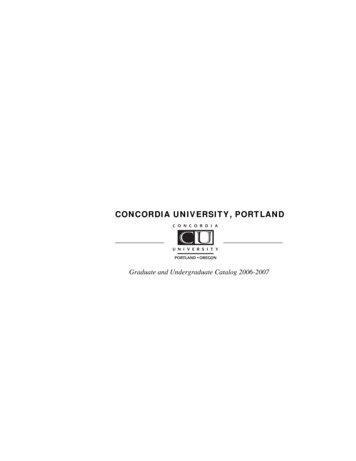
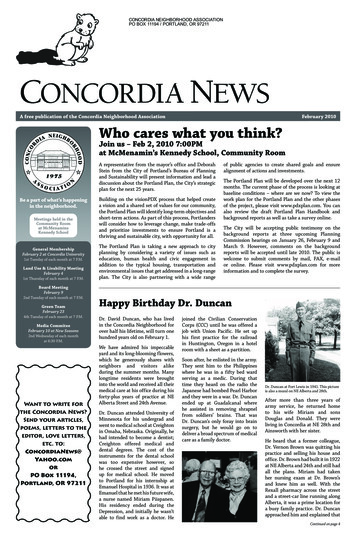



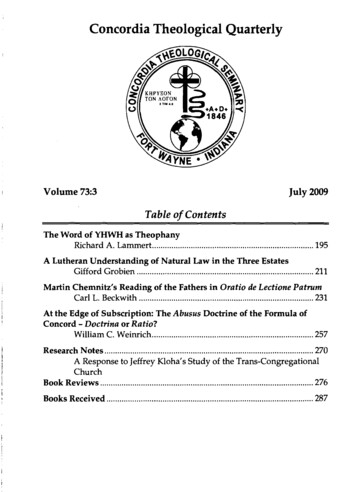
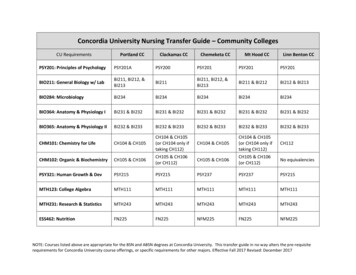

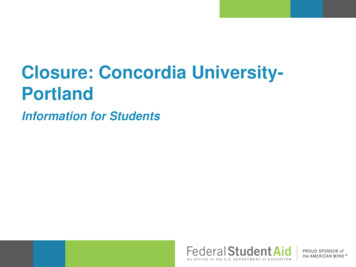
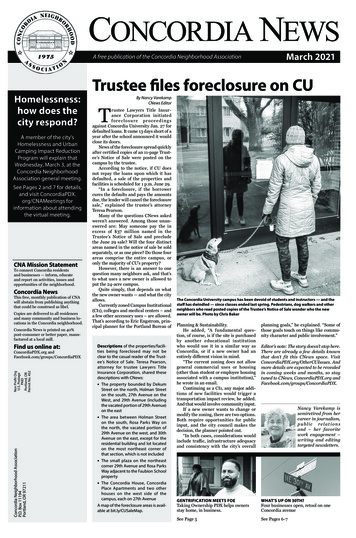
![Concoll i(] Theological Monthly - ctsfw](/img/20/saleskaourenglishbible.jpg)